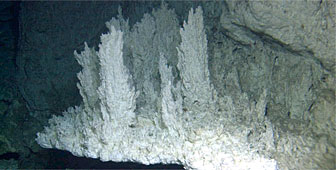
Underwater “city” reveals clues about origin of life

A Swiss geologist is among a team of researchers who have discovered clues about how life was able to gain a foothold on Earth. During an expedition to the mid-Atlantic Ridge, the team found bacteria living in conditions thought to be similar to those which prevailed shortly after the planet had formed.
During their research some 15 kilometres from the Mid-Atlantic Ridge, the scientists discovered a new type of hydrothermal vent in the ocean floor, which they believe provides ideal conditions for bacteria to develop.
“At first, we thought we were looking at a very unusual coral field consisting of very intricate, beautiful white structures,” said Gretchen Bernasconi-Green of the Federal Institute of Technology in Zurich. “Then we realised we were looking at a series of huge hydrothermal structures that no one had ever seen before.”
The new vents are part of an area called the “Lost City”, sitting partly on the seafloor mountain, Atlantis Massif. They are also the first hot water vents discovered away from an ocean ridge.
“It’s an ideal type of environment for bacteria to develop,” Bernasconi-Green told swissinfo. “The seawater mixes with rock in the Earth mantle producing… methane and hydrogen gas. Bacteria feed off this gas.”
The scientists believe life could have originally appeared in similar environment to that of the “Lost City”. Conditions there are thought to resemble those on Earth before there was any kind of atmosphere.
The discovery follows that of other earlier scientific expeditions to the Ridge, which found other vents, known as “black smokers”.
Micro-organisms were also observed living around these vents, revealing that they were able to survive in conditions previously thought unable to support life.
Further research should show how primitive life forms survive in such inhospitable environments.
“Scientists such as myself are just beginning to realise the link between inorganic and biological processes is very important,” Bernasconi-Green told swissinfo. “We would like to go back the area to try and see if we can find some links to the origin of life.”
The 10,000-kilometre long Ridge is the point where the Earth’s crust splits and pushes the Americas and Europe slowly away from each other. Iceland is the only place where the Ridge is visible at the surface.
swissinfo

In compliance with the JTI standards
More: SWI swissinfo.ch certified by the Journalism Trust Initiative

























You can find an overview of ongoing debates with our journalists here . Please join us!
If you want to start a conversation about a topic raised in this article or want to report factual errors, email us at english@swissinfo.ch.